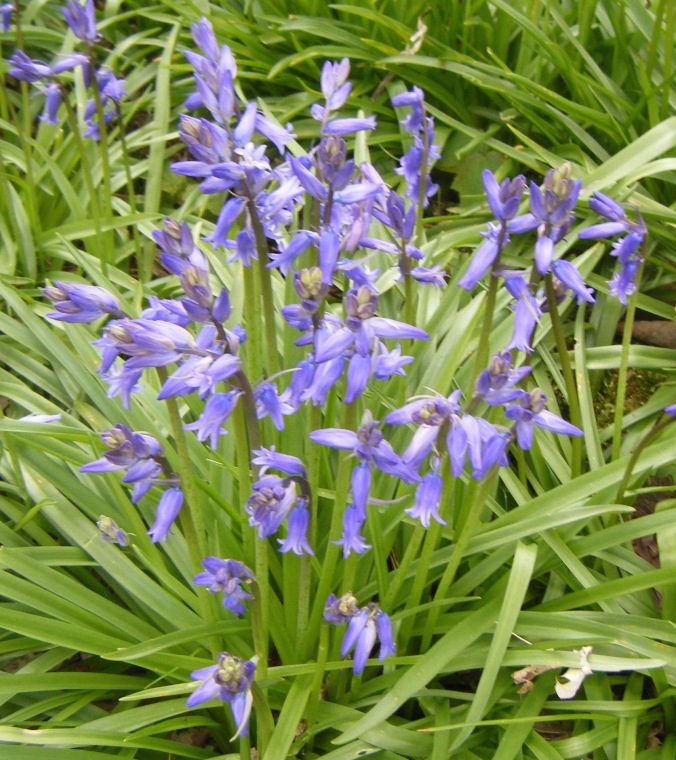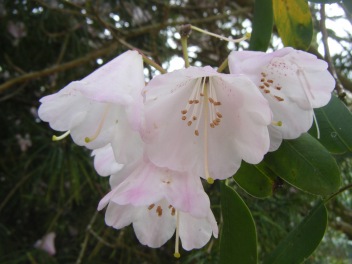As you travel up the drive to Witton Hall, bluebells stretch out either side under a canopy of deciduous woods. Confusingly there are in fact two Witton Halls in Norfolk; this one is near North Walsham whilst the other is closer to Norwich.
The original Hall was burnt down, the footings of which can still be seen. This entry into the Norfolk NGS booklet is not so much a garden; certainly no neatly mown lawns and sumptuous flower beds. It is however a walk through glorious woods.

This resplendent beauty greets us at the top of the drive.

The wooded walk begins over on the other side of the grass. On Open Day there will be a tent here serving teas.

You can see why a house was sited here, the view to Happisburgh and the sea is memorable. It is permitted on the Open Day to walk across the field to the local church (not visible in the next picture).

It came as a surprise to me to discover that bluebells are part of the asparagus family. There is no doubt that these are the ‘real McCoy’ but do we know how to tell the difference between the native hyacinthoides non-scripta, and the Spanish immigrant hyacinthoides hispanica ? I quote from the Woodland Trust:
‘The easiest way to tell the difference between native and non-native bluebells is to look at the colour of the pollen. If it is creamy-white then the bluebell is native. If it is any other colour such as pale green or blue than it’s not native.’
If you don’t want to lie down on the woodland floor in order to check this out then there are other clues too. The sweet smell being the most noticeable one.
A clump of bluebells, which many of us might have in our garden, is a joy

but a carpet of bluebells on the floor of natural woodland is just stunning.

There are many varieties of rhododendrons here. I garden on chalk so am not an expert but I know this is the bright and fragrant Rhododendron luteum.

Is there another genus with such a range of vibrant colour?

It is interesting to see the development of the opening flower all happening on the same bush:
Variations can be subtle, here it is in the colour of the flower stalks.
Evergreens break up the palette allowing the eye not to become too overwhelmed by the splash of colour. Some such as the ilex are variegated.

So too is there variegation on this unusual Stachyrus praecox ‘Magpie’.

We follow the path through naturally formed archways of dark laurel,

and into areas where the soft fresh green of an acer spreads its elegant branches.

The gentle Magnolia stellata, hails from Japan

While this shocking pink of a type of magnolia lilliflora comes from China.

Another Chinaman is the Handkerchief tree, davidia involucrata whose dark flower heads are enveloped by white bracts.

Conifers play their part in the woods. From the fairly recently planted Cryptomeria japonica,

to this unidentified specimen; once bought as a low growing prostrate shrub, like Alice it just grew and grew!

There is a profusion of blossom on the rounded bush of an exochordia x macrantha which grows on the edge of the wood.

A wooden throne sits with its back to the wood. It is not far from the house and the garden owner assures me that it is very comfortable.

From the throne you can admire the perfect camellia growing luxuriently on the corner of the house. Totally deprived of feed it is hard to believe that it suffers a hard prune each year.

We weren’t the only visitors today. Early in the morning six red deer ambled across the lawn. Badgers, muntjac, squirrels and rabbits all share this garden. In such places you live with the wildlife and it is they who dictate how the garden should grow.

Witton Hall is open this coming Monday 1st May between 12-4pm. The entrance is just £3.00 with children going free. There are surely not so many places where, for such a minimal cost one can take children to run along the paths through the bluebells, experience the natural colours and enjoy the freedom of the woods.
——-31——





A great write up which will hopefully draw in visitors who have not been before! There is something special about a blue carpet of English bluebells!
LikeLiked by 1 person